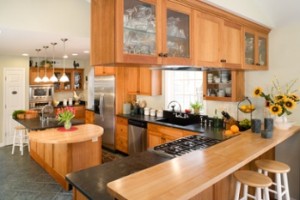 Choosing a material for your countertops can be a huge decision – one that you’ll have to stick with for years (unless you’re remodeling for resale, of course). In part 1 of this post, we overviewed some popular countertop options and key characteristics of each. Since countertop options abound, we’ll continue with more below.
Choosing a material for your countertops can be a huge decision – one that you’ll have to stick with for years (unless you’re remodeling for resale, of course). In part 1 of this post, we overviewed some popular countertop options and key characteristics of each. Since countertop options abound, we’ll continue with more below.
Keep these in mind, and ask your designer about those that interest you to find out if they’re truly a viable option for your project:
Choosing is tough
Soapstone is a natural metamorphic rock made from mineral deposits. As a countertop option, soapstone is very smooth and usually come in a dark gray color (which often forms a darker patina through the years). Soapstone is softer than granite and is not only used in countertops, but often integrated as a sink material as well. It is somewhat stain-resistant, but requires regular maintenance and may scratch or chip on the edges.
Marble is a soft natural stone that is quite expensive. Because of the expense, it often used in select areas, and not used for the whole countertop. Marble is waterproof and heatproof but needs to be sealed to prevent staining and requires much maintenance. If you’re bothered by stains or dulling, and don’t want to watch your every move in the kitchen, marble probably isn’t for you.
Laminate countertops are easy to maintain and come in many colors and patterns. They are durable, inexpensive and offer nice look. However, scratches and chips can occur over time, and repairs are difficult to make.
Concrete countertops are extremely strong, heat and scratch resistant. They can be tinted with color, include inlays and can be poured into molds right in your kitchen to create the shape you want. To prevent staining, you need to properly seal and wax the concrete. Over time, the concrete may crack.
Wood or Butcher Block countertops come in a variety of colors and finishes. The wood is easy to maintain, and over time, you can reseal or sand the surface as needed to refresh the look. Keep in mind that wood can stain, absorb food odors and water can also damage and create dark areas on the surface. Any scratches that occur should be sealed or oiled.
While there are still many options available when it comes to countertop materials, these cover some of the more popular options. Let us know your favorite in the comments below!

Recent Comments